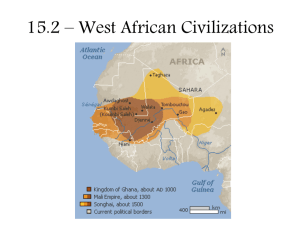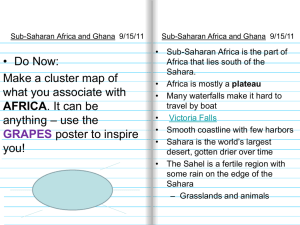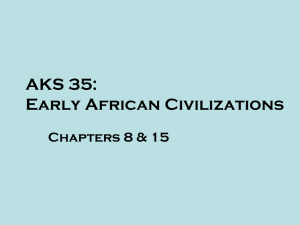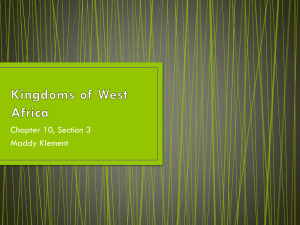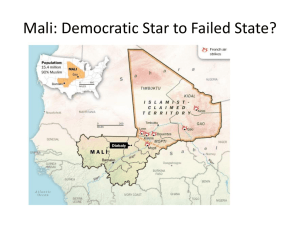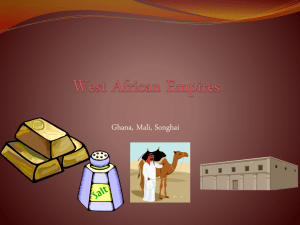Sub-Saharan Africa during the Post-Classical Age
advertisement
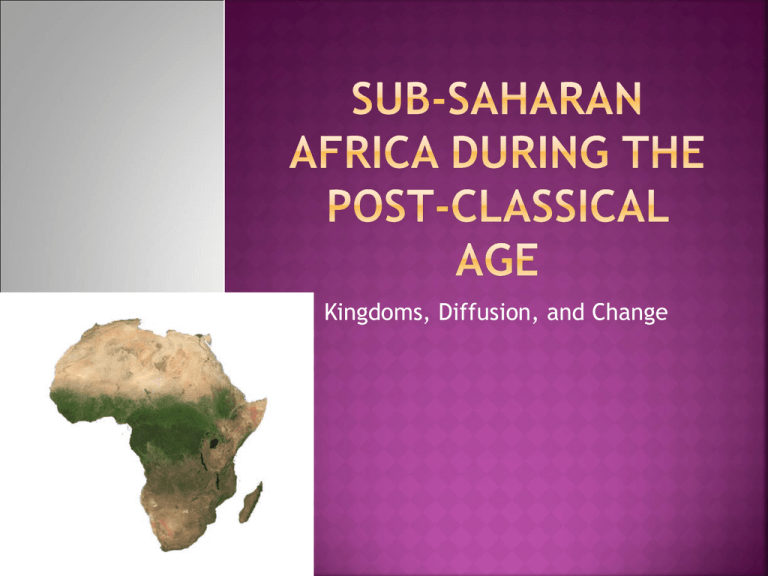
Kingdoms, Diffusion, and Change Not just physically, but also culturally and politically, Africa is divided by the Sahara desert The Sahara is the world’s largest desert During the Post-Classical age, almost all of Saharan Africa and the northern continent had fallen into the orbit of the Islamic world But the story of sub-Saharan Africa is much more complex The Sahel is the semidesert southern fringe of the Sahara In sub-Saharan Africa, the development of strong, sizable political units occurred later and more slowly than in many other parts of the world Much of this had to do with the tremendous varieties of ethnicity and language in subSaharan Africa For example, more than 2,000 languages and dialects are spoken in the region One of the few common threads shared by many – but not all – peoples of sub-Saharan Africa is descent from the Bantu tribes Around 1000 B.C.E., the Bantu began to move out of their homelands in west central Africa By 1000 C.E., descendants of the Bantu tribes had settled in almost all parts of the continent south of the Sahara With the passage of time, however, each smaller group developed its own distinct language and cultural tradition Another factor limiting the growth of major states was environmental The fluctuating climate of subSaharan Africa and human susceptibility to various insect- and animal-borne diseases in subSaharan regions were both obstacles to increasing the size of local populations and the number of workers available to cultivate the land Most sub-Saharan communities were small Social life revolved around the village Food was provided by means of a combination of hunting, herding, and limited agriculture It appears that most African societies gained the skill of metalworking on their own, rather than having it taught to them by outsiders, as was commonly thought until recently Women in sub-Saharan Africa tended to be treated as subservient to men However, women were often valued for their labor as fieldworkers (while men tended cattle) and for producing heirs Women were also respected for their storytelling abilities and their role in educating young people about moral values and religious beliefs Interestingly, unlike in most other societies, in Africa, lineage was sometimes matrilinear, rather than patrilinear Women often inherited property and the husband was required to move into his wife’s house African tribes possess a high degree of skill in carving and sculpture, especially in wood and ivory Metal sculptures became more common over time By the thirteenth and fourteenth centuries, West African artists were creating masterpieces out of bronze and ivory In Ife, in present-day Nigeria, metal workers formed bronze and iron statues by designing molds with melted wax These sculptures may have influenced the work of metalworkers from the West African state of Benin Such artists are famous for their sophisticated and detailed bronze, brass, and copper sculptures of heads, ornaments, animal figures, and reliefs depicting court life Architecture in Africa varied across regions due to diverse cultural influences In sub-Saharan Africa, Greater Zimbabwe stood out for its impressive stone buildings and walls The stones had been carefully cut and then set in place without mortar In Mali, fourteenth-century builders used timber as skeletons in reinforcing mud mosques that still stand today African literature of this period was preserved less by the written language than by oral tradition In their narratives, professional storytellers chronicled history and social custom They also acted as entertainers and served as advisers to kings The most famous epic of sub-Saharan Africa from these years is Son-Jara (or Sundiata) from Mali A griot was a West African storyteller A griot perpetuated the oral traditions of a family or village The griot carries the cultural knowledge and identity of each people The griot legacy stretches back for hundreds, and in some cases, thousands of years The griot is a chronicler of history – keeping track of the history and developments of his people over time The griot is also guardian of the knowledge of his people’s ancestry, or genealogy As time passed, there was increased interaction between North Africa and the sub-Saharan part of the continent This included trade Unfortunately, it also included slavery: for hundreds of years, Arab slavers from the Middle East penetrated to the south, capturing Africans and forcing them into bondage To a good extent, Islam became part of subSaharan life In West Africa, the state of Mali, with its great city of Timbuktu, was an important part of the Islamic world Muslims also brought their religion to the cities of the eastern coast The spread of Islam brought trade to previously isolated parts of southern Africa Still, in comparison to North Africa, which became almost completely Muslim, Islam’s presence in sub-Saharan Africa was not as extensive The greatest of early Sudanic (a region in North Africa, South of the Sahara and Libyan deserts, extending from the Atlantic to the Red Sea) civilizations was Ghana Ghana was founded in the fourth century C.E. on the main caravan route to north Africa At its height in the tenth century, Ghana controlled an area extending from the Atlantic Ocean almost to Timbuktu Ghana controlled the prosperous salt for gold trade This trade connected North Africa and West Africa North African salt was exchanged for West African gold While Ghana did not control the salt or gold deposits, its location allowed it to tax traders entering the region As such, Ghana was called “the land of gold” though it owned no gold fields Ghana’s capital of Koumbi Saleh hosted a prosperous Muslim community of merchants linked to the Trans-Saharan trade routes Over time, Ghana’s ecological and demographic conditions weakened its society As its population grew, its food production failed to meet demand in what was by then an extremely arid environment All of this left Ghana vulnerable to Muslim conquest, the immediate cause of Ghana’s downfall Berbers from the desert moved against Ghana in 1062, but not until 1076 were they able to capture the capital Yet the nomads were unable to benefit from their conquest, for they soon began fighting among themselves, and Ghana became independent once again However, the kingdom was never able to recover its trade or repair the damage done to its agriculture, and the empire began to break up into tribal units With the decline of Ghana, Mali (which probably had been a subject nation) grew, and the Mali empire was firmly established in the upper Niger River valley by Sundiata (1230-1255) Sundiata adopted Islam and Mali became a Muslim kingdom By the fourteenth century Mali controlled the upper Niger west to the Atlantic and all the land north of the forest and east along the Niger to Hausaland Sundiata Keita rose to power by defeating the king of the Sosso - Soumaoro (Sumanguru), known as the Sorcerer King, in 1235 He then brought all the Mandinke clans rulers (or Mansas) under his leadership, declaring himself overall Mansa He took Timbuktu from the Tuareg, transforming it into a substantial city, a focus for trade and scholarship A significant portion of the wealth of the Empire derived from the Bure goldfields The first capital, Niani, was built close to this mining area Gold was not its only mainstay Mali also acquired control over the salt trade The capital of Niani was situated on the agriculturally rich floodplain of upper Niger, with good grazing land further north A class of professional traders emerged in Mali In the 14th century, cowrie shells were established as a form of currency for trading and taxation purposes Mali reached its peak in the 14th century Mansa Musa was a significant king of Mali during its height Mansa Musa (1312-1337) was immortalized in the descriptions of Arab writers, when he made his magnificent pilgrimage to Mecca in 1324 “It is said that he brought with him 14,000 slave girls for his personal service. The members of his entourage proceeded to buy Turkish and Ethiopia slave girls, singing girls and garments, so that the rate of the gold dinar fell by six dirhams. Having presented his gift he set off with the caravan." - Cairo born historian alMaqurizi Mansa Musa also spent his wealth to more permanent effect He commissioned the design and construction of a number of stunning buildings, for example, the building of the mosques at Gao and Jenne Timbuktu became a place of great learning with young men linked to Fez in the north The court of Mali converted to Islam after Sundiata As in Ghana, Muslim scribes played an important role in government and administration But traditional religion persisted Arab historians make much of the Islamic influence in Mali, whereas oral historians place little emphasis on Islam in their histories Ibn Battuta visited Mali This great medieval writer of travel literature rivals the significance of his contemporary Marco Polo Setting out from his native Morocco in the 14th century he travelled – or claims to have travelled – the important regions of the medieval world stretching from west Africa to China A combination of weak and ineffective rulers and increasingly aggressive raids by Mossi neighbors and Tuareg Berbers gradually reduced the power of Mali In the east, Gao began its ascendancy while remaining part of the Mali Empire In the early 1400's, Tuareg launched a number of successful raids on Timbuktu They did not disrupt scholastic life or commercial activity, but fatally undermined the government by appropriating taxes for themselves Mali collapsed when one of its vassals, the King of Songhai, broke away in the fifteenth century and eventually captured Mali territory, ending up with an empire even greater than Mali The capital of Songhai was Goa, and its wealth was based on control of the salt mines King Mohammed Askia’s reign (1493-1528) was exceptional The city of Timbuktu became his center of learning, a university was built, and clerics, judges, and scholars flourished under his patronage Songhai fell to the Moroccans in1591 Muslims had little influence in east Africa until the thirteenth century Although they occupied the coastline and most of the land along the eastern frontier of Abyssinia (Ethiopia) and although by the tenth century a series of Muslim trading states had been built, Christian Abyssinia was able to dominate them and force them to pay tribute Ethiopia became Christian during the fourth century A.D. This domination eventually led, in the fifteenth century, to religious wars between Abyssinia and the Muslims From the 1250s to the 1450s, the most powerful of the central African states was the one that emerged around the cities of Mutapa and Great Zimbabwe Politically linked, Mutapa and Great Zimbabwe controlled seven hundred miles of the Zambezi river basin The larger and more important of the two cities was Great Zimbabwe (ca. 1000-1400) Its name means “sacred graves of the chiefs” Great Zimbabwe was crucial as both a political and religious center Zimbabwe was a great walled city, encircling 193 acres It is clear that the people of Great Zimbabwe were skilled builders Great Zimbabwe was reputed to be immensely wealthy, thanks to large deposits of gold and diamonds The city gained its wealth from the gold trade Gold was shipped east to Sofala, where it became part of the East African-Indian Ocean coastal trade complex Rumors of Great Zimbabwe’s wealth – and lost treasures and hidden mines – persisted for hundreds of years, long after the city itself collapsed in the mid-to-late 1400s
